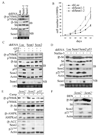p53 target genes sestrin1 and sestrin2 connect genotoxic stress and mTOR signaling
- PMID: 18692468
- PMCID: PMC2758522
- DOI: 10.1016/j.cell.2008.06.028
p53 target genes sestrin1 and sestrin2 connect genotoxic stress and mTOR signaling
Erratum in
- Cell. 2009 Jan 23;136(2):378
Abstract
The tumor suppressor p53 is activated upon genotoxic and oxidative stress and in turn inhibits cell proliferation and growth through induction of specific target genes. Cell growth is positively regulated by mTOR, whose activity is inhibited by the TSC1:TSC2 complex. Although genotoxic stress has been suggested to inhibit mTOR via p53-mediated activation of mTOR inhibitors, the precise mechanism of this link was unknown. We now demonstrate that the products of two p53 target genes, Sestrin1 and Sestrin2, activate the AMP-responsive protein kinase (AMPK) and target it to phosphorylate TSC2 and stimulate its GAP activity, thereby inhibiting mTOR. Correspondingly, Sestrin2-deficient mice fail to inhibit mTOR signaling upon genotoxic challenge. Sestrin1 and Sestrin2 therefore provide an important link between genotoxic stress, p53 and the mTOR signaling pathway.
Figures







References
-
- Astrinidis A, Cash TP, Hunter DS, Walker CL, Chernoff J, Henske EP. Tuberin, the tuberous sclerosis complex 2 tumor suppressor gene product, regulates Rho activation, cell adhesion and migration. Oncogene. 2002;21:8470–8476. - PubMed
-
- Averous J, Fonseca BD, Proud CG. Regulation of cyclin D1 expression by mTORC1 signaling requires eukaryotic initiation factor 4E-binding protein 1. Oncogene. 2007 - PubMed
-
- Averous J, Proud CG. When translation meets transformation: the mTOR story. Oncogene. 2006;25:6423–6435. - PubMed
-
- Budanov AV, Sablina AA, Feinstein E, Koonin EV, Chumakov PM. Regeneration of peroxiredoxins by p53-regulated sestrins, homologs of bacterial AhpD. Science. 2004;304:596–600. - PubMed
-
- Budanov AV, Shoshani T, Faerman A, Zelin E, Kamer I, Kalinski H, Gorodin S, Fishman A, Chajut A, Einat P, et al. Identification of a novel stress-responsive gene Hi95 involved in regulation of cell viability. Oncogene. 2002;21:6017–6031. - PubMed
Publication types
MeSH terms
Substances
Grants and funding
LinkOut - more resources
Full Text Sources
Other Literature Sources
Molecular Biology Databases
Research Materials
Miscellaneous

